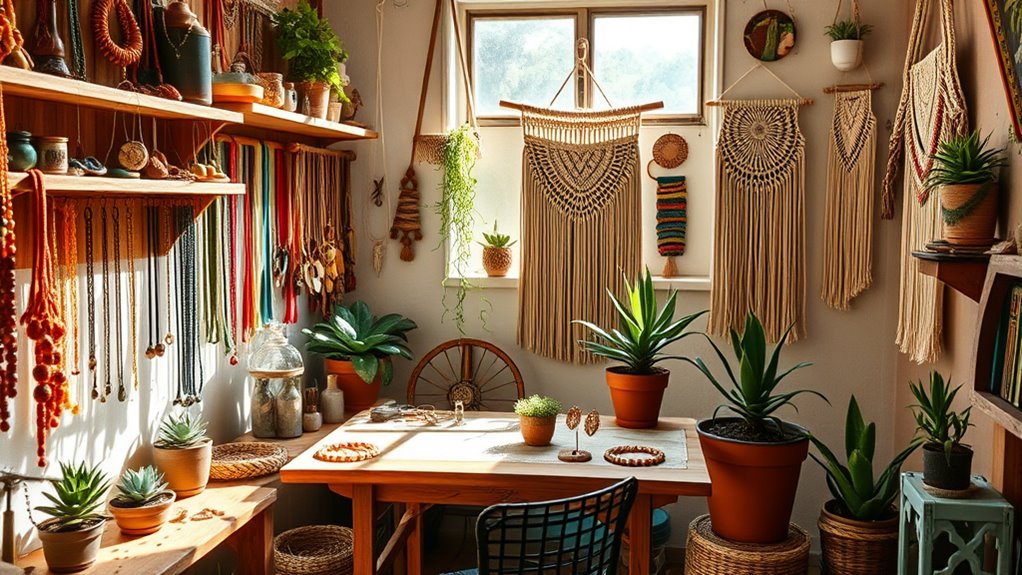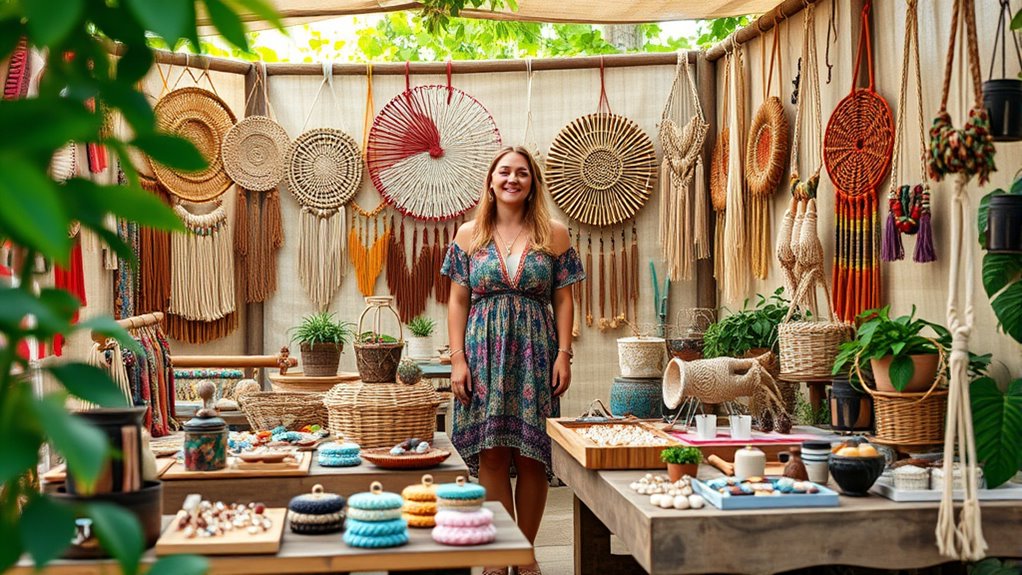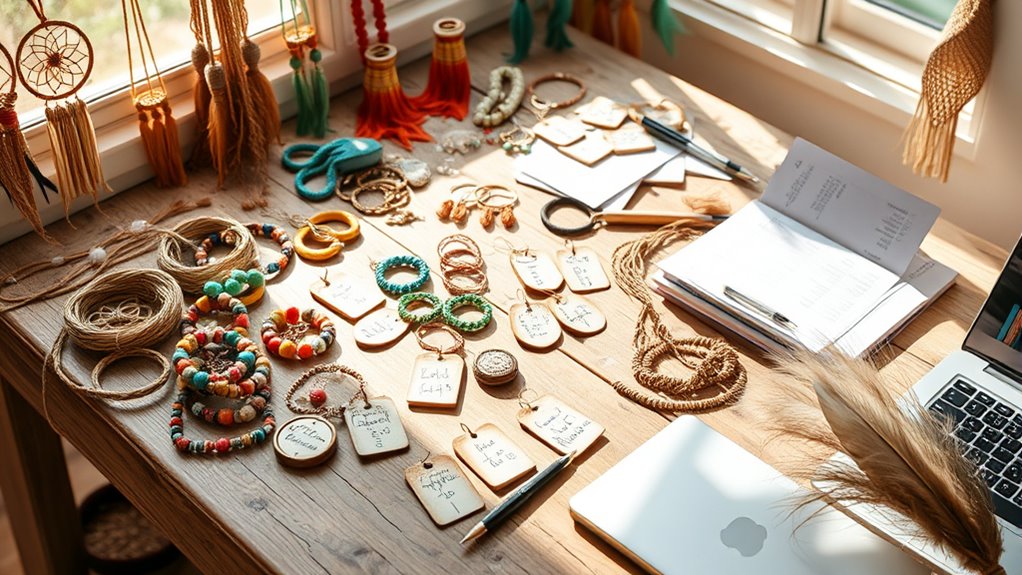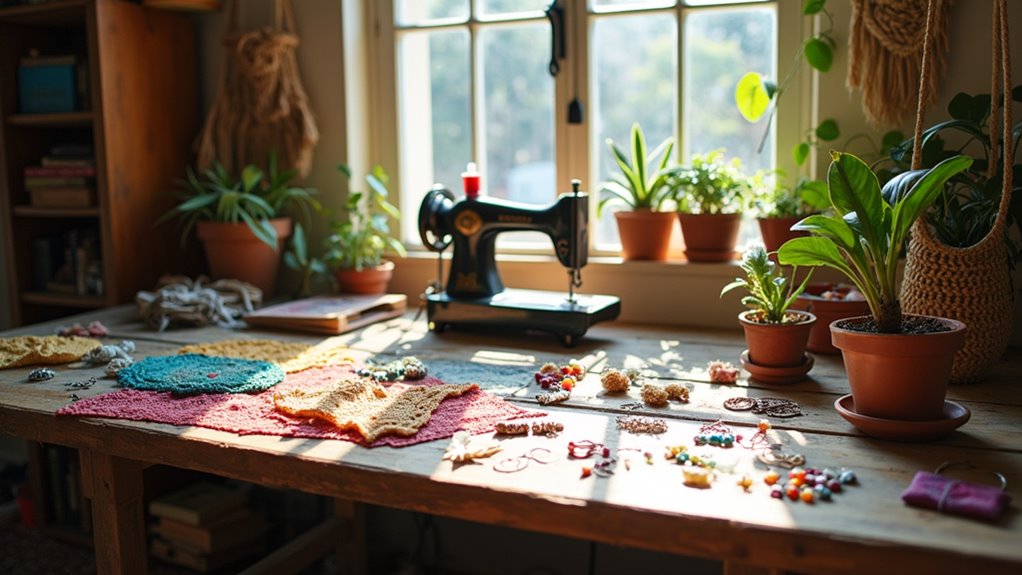Turning your boho crafts into a small business starts with recognizing market interest and building a solid foundation. Develop a memorable brand, choose a unique name, and make sure you have the right licenses and financial setup. Overcome fears by taking small steps and stay motivated. Focus on marketing through social media and community engagement, and manage your prices carefully to make a profit. Keep improving your skills and strategies, and you’ll find new ways to grow your hustle along the way.
Key Takeaways
- Validate market demand by sharing your crafts with friends, family, and local markets to gauge interest and gather feedback.
- Develop a strong brand identity with cohesive visuals, unique business name, and professional packaging to attract loyal customers.
- Register necessary licenses, open dedicated business accounts, and ensure legal compliance for sustainable growth.
- Price products with at least 50% markup, factoring in all costs, and explore multiple sales channels like online platforms and craft fairs.
- Overcome fear by taking small, manageable steps, leveraging support systems, and maintaining consistency to build confidence and momentum.
Recognizing the Spark: Turning Your Hobby Into a Business Opportunity

Turning your boho craft hobby into a business starts with recognizing the signs of potential. Your hobby is more than just a pastime—it’s a window into a market that’s enthusiastic for unique, handmade items. Notice when friends, family, or coworkers start asking to buy your creations or offer payment; that’s a clear sign of market interest. As you produce more, consider if your craft can be made consistently and scaled for sales. Pay attention to your passion and demand—if your hobby resonates with others and shows signs of sustainable profit, it’s time to explore turning it into a business. Starting as a hobby gives you a low-risk way to test the waters and see if your craft can meet market needs. Additionally, understanding color accuracy and visual presentation can help you craft products that appeal more effectively to your target audience. Recognizing the importance of a cohesive design aesthetic can also help you create a recognizable brand identity that attracts loyal customers. Being aware of market trends can further guide you in aligning your products with current consumer preferences and boost your chances of success. Incorporating vertical storage solutions or multifunctional furniture into your workspace can help keep your crafting area organized and efficient as your business grows. Furthermore, selecting a dog name that reflects your brand personality can create a memorable identity that resonates with your customers.
Laying the Foundation: Essential Steps to Start Your Craft Business

To get your craft business off the ground, you need a strong foundation. Start by choosing a memorable business name and securing the necessary licenses to stay compliant. Setting up dedicated financial accounts will also help you keep your business finances organized from the beginning. Considering reliable tools like the Vetted Flat Iron Bike can be a smart addition if you plan to incorporate eco-friendly transportation options for your deliveries or mobile craft shop. Additionally, exploring best laundry detergents can help ensure your craft supplies and materials stay clean and well-maintained. Understanding the history of pinball machines can inspire creative themes or vintage-inspired designs for your crafts, adding a unique touch that appeals to enthusiasts. When planning your asset division, consider cost-effective strategies for asset division to help manage resources efficiently as your business grows. Being aware of building codes and zoning regulations is also important if you plan to operate a dedicated workspace or storefront, ensuring compliance and smooth operations.
Choose a Business Name
Choosing a memorable and unique business name is a crucial first step in establishing your craft brand. Your business name shapes your brand identity and helps attract customer recognition. Make sure it reflects your craft niche and is easy to spell, pronounce, and remember. Before settling on a name, check for existing trademarks to avoid legal issues. Also, verify domain name availability to secure your online presence and make it easy for customers to find you. Register your business name with local or state authorities to formalize your craft business and obtain necessary licenses. Keep future growth in mind; choose a name that allows flexibility as your craft business expands or diversifies. A strong, clear name sets the foundation for your craft journey.
Obtain Necessary Licenses
Before you start selling your craft products, it’s essential to obtain the necessary licenses and permits. A business license or sales tax permit is typically required to operate legally. Requirements vary by state and local jurisdiction, so check with your city or county government to guarantee you meet all regulations. Registering your craft business with the appropriate authorities helps establish legitimacy and shields your personal assets. Keep in mind that some craft items, like food or cosmetics, may need specialized permits or health department approvals. Securing the right licenses and permits not only ensures compliance but also helps you avoid costly fines and potential business disruptions. Additionally, understanding the regulatory environment for your specific craft niche can help you stay ahead of legal requirements. Staying informed about local regulations can further prevent unexpected obstacles, and taking these steps early on sets a solid foundation for your small craft business to grow confidently and legally. It’s also beneficial to familiarize yourself with organic and natural product standards, especially if you plan to market your crafts as eco-friendly or health-conscious.
Set Up Financial Accounts
Have you set up dedicated business checking and savings accounts yet? Opening these business accounts helps keep your personal and craft finances separate, making financial tracking easier and tax filing simpler. Using a business account also boosts your credibility with customers and suppliers, showing professionalism. Many banks offer small business accounts with lower fees and tailored services, so shop around to find the best fit. Accurate records of income and expenses through these accounts are vital for tax compliance and understanding your profitability. Establishing these accounts early creates a solid financial foundation for your craft business and supports future growth. Additionally, Kia Tuning options like ECU remapping and suspension upgrades can help optimize your vehicle for business-related travel or transportation needs. Utilizing financial management tools can further streamline your bookkeeping and reporting processes, reducing financial errors and enhancing overall efficiency. Incorporating AI-powered financial software can also provide valuable insights and automation to manage your business finances more effectively.
Developing a Unique Brand and Product Line for Your Boho Creations

Creating a strong and memorable brand is essential for standing out in the boho craft market. Your brand identity should reflect the earthy, natural vibe of boho style through a memorable name and cohesive visual elements like earthy color palettes and motifs. When developing your product line, focus on niche crafts such as macrame wall hangings, beaded jewelry, or woven textiles that differentiate you from competitors. Adding personalized options like custom charms or tailored sizes can attract loyal customers. Conduct market research on current boho trends and customer preferences to refine your offerings and meet demand. Consistent branding across packaging, social media, and your online store reinforces your business identity, making your unique boho craft line easily recognizable and memorable.
Overcoming Fears and Embracing Action for Business Growth

Overcoming fears is a crucial step in growing your boho craft business, even when doubt and uncertainty try to hold you back. Fear can feel paralyzing, but taking action—even small, manageable steps—builds momentum. Successful entrepreneurs often do it scared, knowing that courage is essential for growth. Ruth Soukup emphasizes acting despite fears to create the business and life you want. Using planning tools, setting clear goals, and seeking support can ease anxiety and boost your confidence in decision-making. Remember, persistence and embracing discomfort are key. Each step forward transforms fear into progress, helping you develop resilience and momentum. By choosing action over hesitation, you’ll grow your business and turn your passion into a thriving small enterprise. Developing emotional CQ can help you manage your emotions and stay motivated during challenging times. Additionally, consulting with professionals and leveraging drivetrain maintenance can inspire innovative ideas that set your business apart. Recognizing the importance of well-being tips can also enhance your overall resilience and sustain your entrepreneurial journey. Keeping an eye on your production quantities and understanding variances can help you make informed decisions to improve efficiency and profitability.
Marketing Strategies to Reach Your Ideal Audience

To effectively grow your boho craft business, honing your marketing strategies is essential for reaching your ideal audience. Start by leveraging social media platforms like Instagram and Facebook to run targeted advertising campaigns that connect with people interested in boho crafts. Developing strong branding—through a compelling story and visual identity—helps your business stand out and builds loyalty among your audience. Optimize your product listings and blog content with SEO techniques to improve your search engine ranking, making it easier for potential customers to find you organically. Engage with niche communities and influencers within the boho lifestyle space to expand your reach naturally. Offering exclusive promotions, giveaways, or limited-edition items can also incentivize followers to share your brand and make purchases, boosting visibility and customer loyalty. Additionally, exploring market research to understand your audience’s preferences can help tailor your marketing efforts more effectively. Incorporating butter making techniques into your branding can also add a unique touch that appeals to craft enthusiasts who appreciate traditional methods. Moreover, considering eye patch benefits and their appeal for self-care routines can inspire creative marketing angles that emphasize wellness and relaxation themes in your branding. Utilizing survivalism principles like resourcefulness and sustainability can further differentiate your brand in the competitive craft market. Engaging your audience with stories about craft traditions can deepen their emotional connection to your brand and foster a loyal community.
Managing Finances and Pricing Your Handmade Items Effectively

Managing your finances and pricing your handmade items correctly is essential for ensuring your craft business stays profitable. To do this, you need to carefully calculate both material costs and labor time, aiming for at least a 50% markup to secure profit. Research similar products on platforms like Etsy or craft fairs to set competitive prices that reflect market expectations. Include all expenses—packaging, shipping, transaction fees—in your pricing to avoid undervaluing your work and protect your profit margins. Consider offering tiered pricing, discounts, or bundles to boost sales while covering costs. Regularly review and adjust your prices based on changes in material costs, market trends, and customer feedback to maintain a sustainable and profitable craft business.
Growing Your Small Business: Tips for Sustained Success

Growing your small craft business requires continuous effort and strategic planning. To ensure sustained success, regularly evaluate market trends and listen to customer feedback. This helps you adapt your product offerings and stay competitive. Diversifying your sales channels by exploring new online platforms or local markets can considerably expand your reach. Reinvest profits into marketing, inventory, and skill development to support long-term growth. Building a loyal customer base is essential—offer excellent service, personalized products, and maintain an engaging social media presence. Additionally, analyze your financial metrics regularly and set clear, measurable goals. This approach keeps your small business stable and positions it for scalability, allowing you to thrive amid changing market trends and consumer preferences.
Frequently Asked Questions
How Do I Turn My Craft Hobby Into a Business?
You can turn your craft hobby into a business by treating it seriously. Choose a memorable name, get the necessary licenses, and set up dedicated business accounts. Focus on creating products you love, like jewelry or soap, and set clear goals. Start small, take consistent steps, and use resources like online guides or community support to build confidence. With planning and persistence, your hobby can become a profitable venture.
What Is the Most Profitable Craft to Sell?
Imagine you’re in the 21st century, not the Renaissance, and you wanna know the most profitable craft to sell. Jewelry, especially personalized or statement pieces, usually has high margins and low startup costs. Digital products like downloadable art or planners also offer massive profit potential with zero inventory. Both options let you turn your craft into a lucrative hustle, giving you quick returns and creative freedom.
At What Point Should I Turn My Hobby Into a Business?
You should consider turning your hobby into a business when you notice consistent demand for your boho crafts, with people regularly asking to buy your items or offering payment. If your creations start generating enough income to cover expenses or contribute to your household, it’s a clear sign. Formalize your effort by creating a business name, getting licenses, and setting up dedicated accounts—you’re ready to scale beyond just a hobby.
Do I Need an EIN to Sell Crafts?
Imagine your craft booth bustling with enthusiastic customers—do you need an EIN? If you have employees or operate as a partnership or corporation, yes, you’ll need one. Many online platforms might require it once your sales grow. Even if not required, getting an EIN helps keep your finances organized and looks professional. It’s free and quick to get from the IRS website, making it a smart step as your craft business expands.
Conclusion
Just like Alice stepping through the looking glass, you’re about to enter a new world of opportunity. By turning your boho crafts into a business, you’re embracing your own wonderland of creativity and independence. Trust your instincts, stay true to your unique style, and keep pushing forward. Remember, every great journey begins with a single step—so take yours confidently, and watch your passion transform into a thriving small business.









